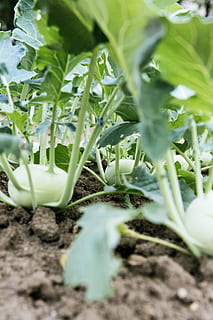Brassica oleracea var. gongylodes
Kohlrabi
Englische Bezeichnung: Cabbage Turnip
Spanische Bezeichnung: Colinabo
Familie
Kreuzblütengewächse (Brassicaceae)
Verwendbare Teile
Wurzelknolle, Blätter
Hauptbestandteile
-
Mineralstoffe: Calcium, Eisen, Kalium, Magnesium
-
Vitamine: B-Vitamine, C, E, Folsäure, Beta-Carotin (Provitamin A)
-
Sekündäre Pflanzenstoffe: Antioxidantien, krebsfeindliche Senfölglycoside
Ernte-Hinweise:
Geerntet wird nicht die gesamte Pflanze, sondern die Blätter mit den Stielen von außen nach innen. Das Herz der Mangoldpflanze soll unverletzt bleiben, damit es weiter wachsen kann.
Verwendung:
Rohkost, Kochen, Dünsten, Schmoren, Blanchieren, Braten, Backen
· z.B.: als Gemüsebeilage, im Salat, als Kohlrabi-Schnitzel oder als Hauptzutat in Eintöpfen, und Aufläufen
Die Knolle wird in Europa schon mindestens seit dem 16. Jahrhundert angebaut. Sie wird vor allem wegen ihres würzigen, rettichartigen Aromas geschätzt. Der Kohlrabi ist wie Brokkoli, Rosenkohl oder Grünkohl eine Varietät des Gemüsekohls. Im Vergleich zu den anderen Zuchtformen ist der Kohlrabi weder ein Blatt- noch ein Blütengemüse, sondern ein Stiel- bzw. Sprossgemüse.
Family
Cruciferous Vegetables (Brassicaceae)
Parts Used:
Root bulb, leaves
Key Constituents:
-
Minerals: Calcium, iron, potassium, magnesium
-
Vitamins: B vitamins, C, E, folic acid, beta-carotene (provitamin A).
-
Secundary plant substances: Antioxidants as well as anti-cancer sulfur-containing glucosinolate compounds, isothiocyanates and sulforaphane
Harvesting Guidelines:
Most varieties of kohlrabi are ready to harvest when they reach about the size of a tennis ball. To do this, simply cut the plant under the bulb.
Use:
Raw, cooking, stewing, braising, blanching, frying, baking
-
e.g.: as a vegetable garnish, in salads, as a kohlrabi schnitzel or as a main ingredient in stews, and casseroles
The cabbage turnip has been cultivated in Europe since at least the 16th century. It is valued above all for its spicy, pungent aroma. Like broccoli, Brussels sprouts or kale, it is a variety of vegetable cabbage. Compared to the other cultivars, kohlrabi is neither a leafy nor a flowering vegetable, but a stalk or shoot vegetable.
Familia
Brassicaceae
Partes aprovechables:
Nabo y Hojas
Principales Constituyentes:
-
Minerales: calcio, hierro, potasio, magnesio
-
Vitaminas: Vitaminas B, C, E, ácido fólico, beta-caroteno (provitamina A)
-
Sustancias vegetales secundarias: Antioxidantes, glucósidos de aceite de mostaza anticancerígenos.
Indicaciones de Cosecha:
La mayoría de las variedades de colirrábano están listas para ser cosechadas cuando tienen el tamaño de una pelota de tenis. Para ello, basta con cortar la planta por debajo del bulbo.
Uso:
cruda, cocinar, guisar, escaldar, freír, hornear.
-
por ejemplo: ejemplo: como guarnición, en ensaladas, como chuletas de colinabo o como ingrediente principal en guisos y estofados.
El nabo se cultiva en Europa desde, por lo menos, el siglo XVI. Se valora sobre todo por su sabor picante y retinto. Al igual que el brócoli, las coles de Bruselas o la col rizada, el colirrábano es una variedad de col vegetal. En comparación con las demás formas cultivadas, el colirrábano no es una hortaliza de hoja ni de flor, sino una hortaliza de tallo o brote.







































